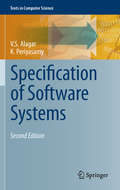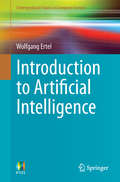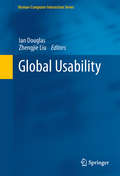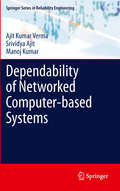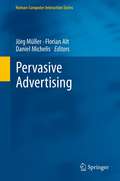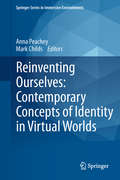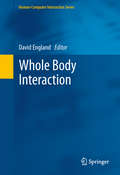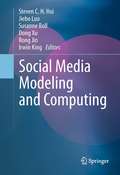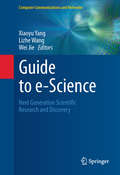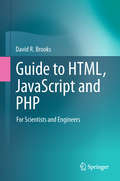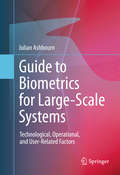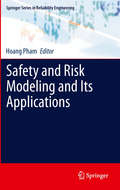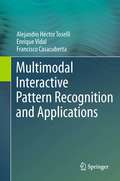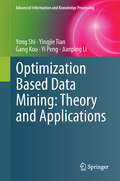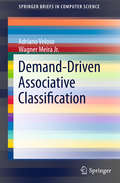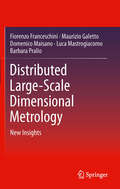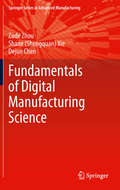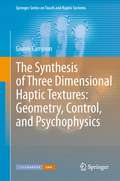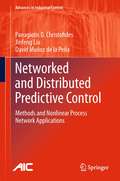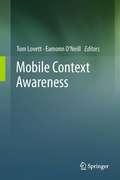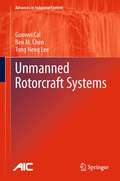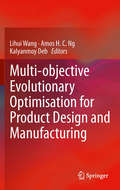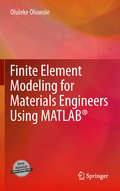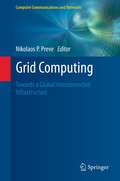- Table View
- List View
Specification of Software Systems
by V. S. Alagar K. PeriyasamyThis extensively revised and updated new edition of Specification of Software Systems builds upon the original focus on software specification with added emphasis on the practice of formal methods for specification and verification activities for different types of software systems and at different stages of developing software systems. Topics and features: provides a wide coverage of formal specification techniques and a clear writing style, supported by end-of-chapter bibliographic notes for further reading; presents a logical structure, with sections devoted to specification fundamentals, basics of formalism, logic, set theory and relations, property-oriented specification methods, and model-based specification techniques; contains end-of-chapter exercises and numerous case studies, with potential course outlines suggested in the Preface; covers Object-Z, B-Method, and Calculus of Communicating Systems; offers material that can be taught with tool-supported laboratory projects.
Introduction to Artificial Intelligence
by Wolfgang Ertel Nathanael T. BlackThis concise and accessible textbook supports a foundation or module course on A.I., covering a broad selection of the subdisciplines within this field. The book presents concrete algorithms and applications in the areas of agents, logic, search, reasoning under uncertainty, machine learning, neural networks and reinforcement learning. Topics and features: presents an application-focused and hands-on approach to learning the subject; provides study exercises of varying degrees of difficulty at the end of each chapter, with solutions given at the end of the book; supports the text with highlighted examples, definitions, and theorems; includes chapters on predicate logic, PROLOG, heuristic search, probabilistic reasoning, machine learning and data mining, neural networks and reinforcement learning; contains an extensive bibliography for deeper reading on further topics; supplies additional teaching resources, including lecture slides and training data for learning algorithms, at an associated website.
Global Usability
by Ian Douglas Zhengjie LiuThe concept of usability has become an increasingly important consideration in the design of all kinds of technology. As more products are aimed at global markets and developed through internationally distributed teams, usability design needs to be addressed in global terms. Interest in usability as a design issue and specialist area of research and education has developed steadily in North America and Europe since the 1980's. However, it is only over the last ten years that it has emerged as a global concern. Global Usability provides an introduction to the important issues in globalizing design and an insight into the development of usability expertise around the world. The book is divided into two sections. The first section deals with the general issues in cross-cultural design and the methods for conducting usability design and evaluation across geographical boundaries. The second section describes the state of usability development in fifteen countries. The descriptions include a history and review of activities and include some unique perspectives that have developed in relation to usability work. Researchers and practitioners from a variety of design-related disciplines will find the book a useful guide for understanding the issues and an excellent reference source for working in any of the countries covered.
Dependability of Networked Computer-based Systems
by Manoj Kumar Srividya Ajit Ajit Kumar VermaThe measurement of dependability attributes on real systems is a very time-consuming and costly affair, making analytical or simulation modeling the only viable solutions. Dependability of Networked Computer-based Systems explores reliability, availability and safety modeling of networked computer-based systems used in life-critical applications such as avionics, nuclear power plants, automobiles and chemical process industries. Dependability of Networked Computer-based Systems gives an overview of basic dependability modeling concepts and addresses new challenges in dependability modeling of networked computer-based systems, as well as new trends, their capabilities and limitations. It covers a variety of dependability modeling methods: stochastic processes,Markov and semi-Markov models,response-time distribution,stochastic Petri-net-based modeling formalisms, andMonte Carlo simulation models.Dependability of Networked Computer-based Systems provides students and researchers with a detailed overview of dependability models and analysis techniques. Practicing engineers will also find this text a useful guide to decision-making based on system dependability at the design, operation and maintenance stages.
Pervasive Advertising
by Daniel Michelis Florian Alt Jörg MüllerThis book looks at the future of advertising from the perspective of pervasive computing. Pervasive computing encompasses the integration of computers into everyday devices, like the covering of surfaces with interactive displays and networked mobile phones. Advertising is the communication of sponsored messages to inform, convince, and persuade to buy. We believe that our future cities will be digital, giving us instant access to any information we need everywhere, like at bus stops, on the sidewalk, inside the subway and in shopping malls. We will be able to play with and change the appearance of our cities effortlessly, like making flowers grow along a building wall or changing the colour of the street we are in. Like the internet as we know it, this digitalization will be paid for by adverts, which unobtrusively provide us suggestions for nearby restaurants or cafés. If any content annoys us, we will be able to effortlessly say so and change it with simple gestures, and content providers and advertisers will know what we like and be able to act accordingly. This book presents the technological foundations to make this vision a reality.
Reinventing Ourselves: Contemporary Concepts of Identity in Virtual Worlds
by Anna Peachey Mark ChildsThe proposed book explores the theme of identity, specifically as applied to its role and development in virtual worlds. Following the introduction, it is divided into four sections: identities, avatars and the relationship between them; factors that support the development of identity in virtual worlds; managing multiple identities across different environments and creating an online identity for a physical world purpose.
Whole Body Interaction
by David EnglandWhole Body Interaction is "The integrated capture and processing of human signals from physical, physiological, cognitive and emotional sources to generate feedback to those sources for interaction in a digital environment" (England 2009). Whole Body Interaction looks at the challenges of Whole Body Interaction from the perspectives of design, engineering and research methods. How do we take physical motion, cognition, physiology, emotion and social context to push boundaries of Human Computer Interaction to involve the complete set of human capabilities? Through the use of various applications the authors attempt to answer this question and set a research agenda for future work. Aimed at students and researchers who are looking for new project ideas or to extend their existing work with new dimensions of interaction.
Social Media Modeling and Computing
by Susanne Boll Irwin King Jiebo Luo Rong Jin Dong Xu Steven C.H. HoiThis timely text/reference presents the latest advances in various aspects of social media modeling and social media computing research. Gathering together superb research from a range of established international conferences and workshops, the editors coherently organize and present each of the topics in relation to the basic principles and practices of social media modeling and computing. Individual chapters can be also be used as self-contained references on the material covered. Topics and features: presents contributions from an international selection of preeminent experts in the field; discusses topics on social-media content analysis; examines social-media system design and analysis, and visual analytic tools for event analysis; investigates access control for privacy and security issues in social networks; describes emerging applications of social media, for music recommendation, automatic image annotation, and the analysis and improvement of photo-books.
Guide to e-Science
by Lizhe Wang Wei Jie Xiaoyu YangThis guidebook on e-science presents real-world examples of practices and applications, demonstrating how a range of computational technologies and tools can be employed to build essential infrastructures supporting next-generation scientific research. Each chapter provides introductory material on core concepts and principles, as well as descriptions and discussions of relevant e-science methodologies, architectures, tools, systems, services and frameworks. Features: includes contributions from an international selection of preeminent e-science experts and practitioners; discusses use of mainstream grid computing and peer-to-peer grid technology for "open" research and resource sharing in scientific research; presents varied methods for data management in data-intensive research; investigates issues of e-infrastructure interoperability, security, trust and privacy for collaborative research; examines workflow technology for the automation of scientific processes; describes applications of e-science.
Guide to HTML, JavaScript and PHP
by David R. BrooksThis book enables readers to quickly develop a working knowledge of HTML, JavaScript and PHP. The text emphasizes a hands-on approach to learning and makes extensive use of examples. A detailed science, engineering, or mathematics background is not required to understand the material, making the book ideally suitable for self-study or an introductory course in programming. Features: describes the creation and use of HTML documents; presents fundamental concepts of client-side and server-side programming languages; examines JavaScript and PHP implementation of arrays, built-in and user-defined methods and functions, math capabilities, and input processing with HTML forms; extends programming fundamentals to include reading and writing server-based files, command-line interfaces, and an introduction to GD graphics; appendices include a brief introduction to using a "pseudocode" approach to organizing solutions to computing problems; includes a Glossary and an extensive set of programming exercises.
Guide to Biometrics for Large-Scale Systems
by Julian AshbournThis book considers biometric technology in a broad light, integrating the concept seamlessly into mainstream IT, while discussing the cultural attitudes and the societal impact of identity management. Features: summarizes the material covered at the beginning of every chapter, and provides chapter-ending review questions and discussion points; reviews identity verification in nature, and early historical interest in anatomical measurement; provides an overview of biometric technology, presents a focus on biometric systems and true systems integration, examines the concept of identity management, and predicts future trends; investigates performance issues in biometric systems, the management and security of biometric data, and the impact of mobile devices on biometrics technology; explains the equivalence of performance across operational nodes, introducing the APEX system; considers the legal, political and societal factors of biometric technology, in addition to user psychology and other human factors.
Safety and Risk Modeling and Its Applications
by Hoang PhamSafety and Risk Modeling presents the latest theories and methods of safety and risk with an emphasis on safety and risk in modeling. It covers applications in several areas including transportations and security risk assessments, as well as applications related to current topics in safety and risk. Safety and Risk Modeling is a valuable resource for understanding the latest developments in both qualitative and quantitative methods of safety and risk analysis and their applications in operating environments. Each chapter has been written by active researchers or experienced practitioners to bridge the gap between theory and practice and to trigger new research challenges in safety and risk. Topics include: safety engineering, system maintenance, safety in design, failure analysis, and risk concept and modelling. Postgraduate students, researchers, and practitioners in many fields of engineering, operations research, management, and statistics will find Safety and Risk Modeling a state-of-the-art survey of reliability and quality in design and practice.
The Connected Home: The Future of Domestic Life
by Richard HarperThe title of this new book: "The Connected Home" reflects the move away from the idea that smart homes would alter the lives of those living in them by providing technologies to take over tasks that were previously the responsibility of the householder, such as managing entertainment, education - and even eating! Up until around 10 years ago this view was commonplace but time has shown that the technologies to support a smart home have not developed in such a way as to support this premise. Instead, what people do in their homes has moved the concept of a smart home into that of the 'connected home'. The rise of on-line games technologies, video connections via Skype, social networking, internet browsing etc are now an integral part of the home environment and have had a significant effect on the home. The contributors to this exciting new book consider and discuss the effects and ramifications of the connected home from a variety of viewpoints: an examination of the take-up of personal computers and the Internet in domestic situations; an analysis of the changing intersection of technology and human habits in the connected home; the impact of gaming, texting, e-book readers, tablets and other devices and their effect on the social conditions of a household; the relationship between digital messaging applications and real geography; and an overview of how sensing technologies for the smart home might evolve (lightweight medical technologies for example). The book culminates by addressing unfinished ambitions from the smart home agenda, the factors that have prevented their realisation, and addresses the need for extending research into the area.
Multimodal Interactive Pattern Recognition and Applications
by Enrique Vidal Francisco Casacuberta Alejandro Héctor ToselliThis book presents a different approach to pattern recognition (PR) systems, in which users of a system are involved during the recognition process. This can help to avoid later errors and reduce the costs associated with post-processing. The book also examines a range of advanced multimodal interactions between the machine and the users, including handwriting, speech and gestures. Features: presents an introduction to the fundamental concepts and general PR approaches for multimodal interaction modeling and search (or inference); provides numerous examples and a helpful Glossary; discusses approaches for computer-assisted transcription of handwritten and spoken documents; examines systems for computer-assisted language translation, interactive text generation and parsing, relevance-based image retrieval, and interactive document layout analysis; reviews several full working prototypes of multimodal interactive PR applications, including live demonstrations that can be publicly accessed on the Internet.
Optimization Based Data Mining: Theory and Applications
by Yong Shi Yingjie Tian Yi Peng Jianping Li Gang KouOptimization techniques have been widely adopted to implement various data mining algorithms. In addition to well-known Support Vector Machines (SVMs) (which are based on quadratic programming), different versions of Multiple Criteria Programming (MCP) have been extensively used in data separations. Since optimization based data mining methods differ from statistics, decision tree induction, and neural networks, their theoretical inspiration has attracted many researchers who are interested in algorithm development of data mining. Optimization based Data Mining: Theory and Applications, mainly focuses on MCP and SVM especially their recent theoretical progress and real-life applications in various fields. These include finance, web services, bio-informatics and petroleum engineering, which has triggered the interest of practitioners who look for new methods to improve the results of data mining for knowledge discovery. Most of the material in this book is directly from the research and application activities that the authors' research group has conducted over the last ten years. Aimed at practitioners and graduates who have a fundamental knowledge in data mining, it demonstrates the basic concepts and foundations on how to use optimization techniques to deal with data mining problems.
Demand-Driven Associative Classification
by Wagner Meira Jr. Adriano VelosoThe ultimate goal of machines is to help humans to solve problems. Such problems range between two extremes: structured problems for which the solution is totally defined (and thus are easily programmed by humans), and random problems for which the solution is completely undefined (and thus cannot be programmed). Problems in the vast middle ground have solutions that cannot be well defined and are, thus, inherently hard to program. Machine Learning is the way to handle this vast middle ground, so that many tedious and difficult hand-coding tasks would be replaced by automatic learning methods. There are several machine learning tasks, and this work is focused on a major one, which is known as classification. Some classification problems are hard to solve, but we show that they can be decomposed into much simpler sub-problems. We also show that independently solving these sub-problems by taking into account their particular demands, often leads to improved classification performance.
Distributed Large-Scale Dimensional Metrology
by Domenico Maisano Fiorenzo Franceschini Luca Mastrogiacomo Barbara Pralio Maurizio GalettoThe field of large-scale dimensional metrology (LSM) deals with objects that have linear dimensions ranging from tens to hundreds of meters. It has recently attracted a great deal of interest in many areas of production, including the automotive, railway, and shipbuilding sectors. Distributed Large-Scale Dimensional Metrology introduces a new paradigm in this field that reverses the classical metrological approach: measuring systems that are portable and can be easily moved around the location of the measured object, which is preferable to moving the object itself. Distributed Large-Scale Dimensional Metrology combines the concepts of distributed systems and large scale metrology at the application level. It focuses on the latest insights and challenges of this new generation of systems from the perspective of the designers and developers. The main topics are: coverage of measuring area,sensors calibration,on-line diagnostics,probe management, andanalysis of metrological performance.The general descriptions of each topic are further enriched by specific examples concerning the use of commercially available systems or the development of new prototypes. This will be particularly useful for professional practitioners such as quality engineers, manufacturing and development engineers, and procurement specialists, but Distributed Large-Scale Dimensional Metrology also has a wealth of information for interested academics.
Fundamentals of Digital Manufacturing Science
by Dejun Chen Shane Shengquan Xie Zude ZhouThe manufacturing industry will reap significant benefits from encouraging the development of digital manufacturing science and technology. Digital Manufacturing Science uses theorems, illustrations and tables to introduce the definition, theory architecture, main content, and key technologies of digital manufacturing science. Readers will be able to develop an in-depth understanding of the emergence and the development, the theoretical background, and the techniques and methods of digital manufacturing science. Furthermore, they will also be able to use the basic theories and key technologies described in Digital Manufacturing Science to solve practical engineering problems in modern manufacturing processes. Digital Manufacturing Science is aimed at advanced undergraduate and postgraduate students, academic researchers and researchers in the manufacturing industry. It allows readers to integrate the theories and technologies described with their own research works, and to propose new ideas and new methods to improve the theory and application of digital manufacturing science.
The Synthesis of Three Dimensional Haptic Textures: Geometry, Control, and Psychophysics
by Gianni CampionThe sense of touch is fundamental during the interaction between humans and their environment; in virtual reality, objects are created by computer simulations and they can be experienced through haptic devices. In this context haptic textures are fundamental for a realistic haptic perception of virtual objects.This book formalizes the specific artefacts corrupting the rendering of virtual haptic textures and offers a set of simple conditions to guide haptic researchers towards artefact-free textures. The conditions identified are also extremely valuable when designing psychophysical experiments and when analyzing the significance of the data collected. The Synthesis of Three Dimensional Haptic Textures, Geometry, Control, and Psychophysics examines the problem of rendering virtual haptic textures with force feedback devices. The author provides an introduction to the topic of haptic textures that covers the basics of the physiology of the skin, the psychophysics of roughness perception, and the engineering challenges behind haptic textures rendering. The book continues with the presentation of a novel mathematical framework that characterizes haptic devices, texturing algorithms and their ability to generate realistic haptic textures. Finally, two psychophysical experiments link the perception of roughness with the parameters of the haptic rendering algorithms. This book formalizes the specific artefacts corrupting the rendering of virtual haptic textures and offers a set of simple conditions to guide haptic researchers towards artefact-free textures. The conditions identified are also extremely valuable when designing psychophysical experiments and when analyzing the significance of the data collected.
Networked and Distributed Predictive Control
by David Muñoz de la Peña Jinfeng Liu Panagiotis D. ChristofidesNetworked and Distributed Predictive Control presents rigorous, yet practical, methods for the design of networked and distributed predictive control systems - the first book to do so. The design of model predictive control systems using Lyapunov-based techniques accounting for the influence of asynchronous and delayed measurements is followed by a treatment of networked control architecture development. This shows how networked control can augment dedicated control systems in a natural way and takes advantage of additional, potentially asynchronous and delayed measurements to maintain closed loop stability and significantly to improve closed-loop performance. The text then shifts focus to the design of distributed predictive control systems that cooperate efficiently in computing optimal manipulated input trajectories that achieve desired stability, performance and robustness specifications but spend a fraction of the time required by centralized control systems. Key features of this book include: * new techniques for networked and distributed control system design; * insight into issues associated with networked and distributed predictive control and their solution; * detailed appraisal of industrial relevance using computer simulation of nonlinear chemical process networks and wind- and solar-energy-generation systems; and * integrated exposition of novel research topics and rich resource of references to significant recent work. A full understanding of Networked and Distributed Predictive Control requires a basic knowledge of differential equations, linear and nonlinear control theory and optimization methods and the book is intended for academic researchers and graduate students studying control and for process control engineers. The constant attention to practical matters associated with implementation of the theory discussed will help each of these groups understand the application of the book's methods in greater depth.
Mobile Context Awareness
by Tom Lovett Eamonn O'NeillMobile context-awareness is a popular research trend in the field of ubiquitous computing. Advances in mobile device sensory hardware and the rise of 'virtual' sensors such as web application programming interfaces (APIs) mean that the mobile user is exposed to a vast range of data that can be used for new advanced applications. Mobile Context Awareness presents work from industrial and academic researchers, focusing on novel methods of context acquisition in the mobile environment - particularly through the use of physical and virtual sensors - along with research into new applications utilising this context. In addition, the book provides insights into the technical and usability challenges involved in mobile context-awareness, as well as observations on current and future trends in the field.
Unmanned Rotorcraft Systems
by Guowei Cai Tong Heng Lee Ben M. ChenUnmanned Rotorcraft Systems explores the research and development of fully-functional miniature UAV (unmanned aerial vehicle) rotorcraft, and provides a complete treatment of the design of autonomous miniature rotorcraft UAVs. The unmanned system is an integration of advanced technologies developed in communications, computing, and control areas, and is an excellent testing ground for trialing and implementing modern control techniques. Included are detailed expositions of systematic hardware construction, software systems integration, aerodynamic modeling; and automatic flight control system design. Emphasis is placed on the cooperative control and flight formation of multiple UAVs, vision-based ground target tracking, and landing on moving platforms. Other issues such as the development of GPS-less indoor micro aerial vehicles and vision-based navigation are also discussed in depth: utilizing the vision-based system for accomplishing ground target tracking, attacking and landing, cooperative control and flight formation of multiple unmanned rotorcraft; and future research directions on the related areas.
Multi-objective Evolutionary Optimisation for Product Design and Manufacturing
by Lihui Wang Kalyanmoy Deb Amos H. NgWith the increasing complexity and dynamism in today's product design and manufacturing, more optimal, robust and practical approaches and systems are needed to support product design and manufacturing activities. Multi-objective Evolutionary Optimisation for Product Design and Manufacturing presents a focused collection of quality chapters on state-of-the-art research efforts in multi-objective evolutionary optimisation, as well as their practical applications to integrated product design and manufacturing. Multi-objective Evolutionary Optimisation for Product Design and Manufacturing consists of two major sections. The first presents a broad-based review of the key areas of research in multi-objective evolutionary optimisation. The second gives in-depth treatments of selected methodologies and systems in intelligent design and integrated manufacturing. Recent developments and innovations in multi-objective evolutionary optimisation make Multi-objective Evolutionary Optimisation for Product Design and Manufacturing a useful text for a broad readership, from academic researchers to practicing engineers.
Finite Element Modeling for Materials Engineers Using MATLAB®
by Oluleke OluwoleThe finite element method is often used for numerical computation in the applied sciences. It makes a major contribution to the range of numerical methods used in the simulation of systems and irregular domains, and its importance today has made it an important subject of study for all engineering students. While treatments of the method itself can be found in many traditional finite element books, Finite Element Modeling for Materials Engineers Using MATLAB® combines the finite element method with MATLAB to offer materials engineers a fast and code-free way of modeling for many materials processes. Finite Element Modeling for Materials Engineers Using MATLAB® covers such topics as: developing a weak formulation as a prelude to obtaining the finite element equation,interpolation functions,derivation of elemental equations, anduse of the Partial Differential Equation ToolboxTM.Exercises are given based on each example and m-files based on the examples are freely available to readers online. Researchers, advanced undergraduate and postgraduate students, and practitioners in the fields of materials and metallurgy will find Finite Element Modeling for Materials Engineers Using MATLAB® a useful guide to using MATLAB for engineering analysis and decision-making.
Grid Computing
by Nikolaos P. PreveThis book presents research from many of the major projects involved in the emerging global grid infrastructure. With a particular focus on the practical advantages and applications of grid computing - including real case studies - the book provides an in-depth study of grid technology for a wide range of different needs. Topics: examines a remote instrumentation infrastructure, and a methodology to support e-science applications on e-infrastructures; describes the GEMS storage system, and pipeline workflows for optimizing end-to-end performance in wide-area networks; investigates semantic grid system architecture, social grid agents, and monitoring platforms designed for large-scale distributed systems; explores job control using service-level agreements; introduces the Composable Services Architecture for dynamic service provisioning, and the semantically driven communication middleware platform, Phoenix; discusses the PhyloGrid application, and a numerical simulation performed using grid computing.
